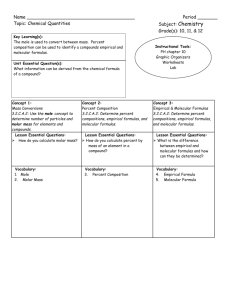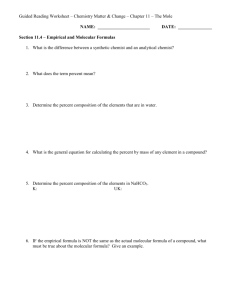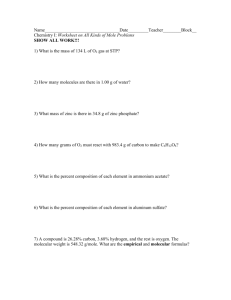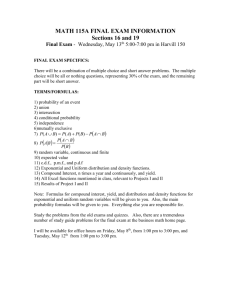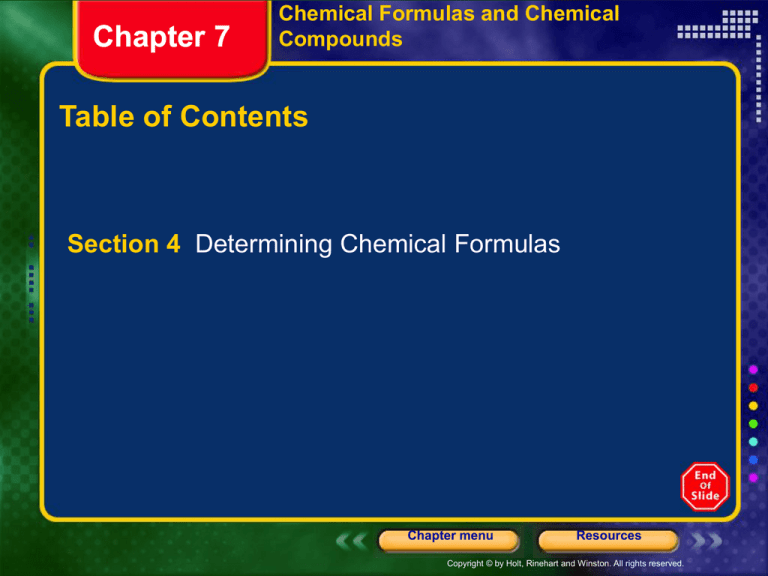
Chapter 7
Chemical Formulas and Chemical
Compounds
Table of Contents
Section 4 Determining Chemical Formulas
Chapter menu
Resources
Copyright © by Holt, Rinehart and Winston. All rights reserved.
Chapter 7
Section 4 Determining Chemical
Formulas
Objectives
• Define empirical formula, and explain how the term
applies to ionic and molecular compounds.
• Determine an empirical formula from either a
percentage or a mass composition.
• Explain the relationship between the empirical
formula and the molecular formula of a given
compound.
• Determine a molecular formula from an empirical
formula.
Chapter menu
Resources
Copyright © by Holt, Rinehart and Winston. All rights reserved.
Chapter 7
Section 4 Determining Chemical
Formulas
Empirical and Actual Formulas
Chapter menu
Resources
Copyright © by Holt, Rinehart and Winston. All rights reserved.
7.4
Percent Composition and
Chemical Formulas
>
Empirical Formulas
Empirical Formulas
What does the empirical formula of a
compound show?
Slide
of 40
4
© Copyright Pearson Prentice Hall
End Show
7.4
Percent Composition and
Chemical Formulas
>
Empirical Formulas
The empirical formula gives the lowest wholenumber ratio of the atoms of the elements in a
compound.
The empirical formula of a compound
shows the smallest whole-number ratio
of the atoms in the compound.
Slide
of 40
5
© Copyright Pearson Prentice Hall
End Show
7.4
Percent Composition and
Chemical Formulas
>
Empirical Formulas
Ethyne (C2H2) is a gas used in
welder’s torches. Styrene
(C8H8) is used in making
polystyrene.
These two compounds of
carbon have the same
empirical formula (CH) but
different molecular formulas.
Slide
of 40
6
© Copyright Pearson Prentice Hall
End Show
Chapter 7
Section 4 Determining Chemical
Formulas
• An empirical formula consists of the symbols for the
elements combined in a compound, with subscripts
showing the smallest whole-number mole ratio of the
different atoms in the compound.
• For an ionic compound, the formula unit is usually the
compound’s empirical formula.
• For a molecular compound, however, the empirical
formula does not necessarily indicate the actual
numbers of atoms present in each molecule.
• example: the empirical formula of the gas diborane is BH3,
but the molecular formula is B2H6.
Chapter menu
Resources
Copyright © by Holt, Rinehart and Winston. All rights reserved.
Chapter 7
Section 4 Determining Chemical
Formulas
Calculation of Empirical Formulas
• To determine a compound’s empirical formula from its
percentage composition, begin by converting
percentage composition to a mass composition.
• Assume that you have a 100.0 g sample of the
compound.
• Then calculate the amount of each element in the
sample.
• example: diborane
• The percentage composition is 78.1% B and 21.9% H.
• Therefore, 100.0 g of diborane contains 78.1 g of B
and 21.9 g of H.
Chapter menu
Resources
Copyright © by Holt, Rinehart and Winston. All rights reserved.
Chapter 7
Section 4 Determining Chemical
Formulas
Calculation of Empirical Formulas, continued
• Next, the mass composition of each element is
converted to a composition in moles by dividing by
the appropriate molar mass.
• These values give a mole ratio of 7.22 mol B to
21.7 mol H.
Chapter menu
Resources
Copyright © by Holt, Rinehart and Winston. All rights reserved.
Chapter 7
Section 4 Determining Chemical
Formulas
Calculation of Empirical Formulas, continued
• To find the smallest whole number ratio, divide each
number of moles by the smallest number in the
existing ratio.
• Because of rounding or experimental error, a
compound’s mole ratio sometimes consists of numbers
close to whole numbers instead of exact whole
numbers.
• In this case, the differences from whole numbers may be ignored
and the nearest whole number taken.
Chapter menu
Resources
Copyright © by Holt, Rinehart and Winston. All rights reserved.
Chapter 7
Section 4 Determining Chemical
Formulas
Calculation of Empirical Formulas, continued
Sample Problem L
Quantitative analysis shows that a compound contains
32.38% sodium, 22.65% sulfur, and 44.99% oxygen.
Find the empirical formula of this compound.
Chapter menu
Resources
Copyright © by Holt, Rinehart and Winston. All rights reserved.
Chapter 7
Section 4 Determining Chemical
Formulas
Calculation of Empirical Formulas, continued
Sample Problem L Solution
Given: percentage composition: 32.38% Na, 22.65% S,
and 44.99% O
Unknown: empirical formula
Solution:
percentage composition
composition in moles
mass composition
smallest whole-number
mole ratio of atoms
Chapter menu
Resources
Copyright © by Holt, Rinehart and Winston. All rights reserved.
Chapter 7
Section 4 Determining Chemical
Formulas
Calculation of Empirical Formulas, continued
Sample Problem L Solution, continued
Chapter menu
Resources
Copyright © by Holt, Rinehart and Winston. All rights reserved.
Chapter 7
Section 4 Determining Chemical
Formulas
Calculation of Empirical Formulas, continued
Sample Problem L Solution, continued
Smallest whole-number mole ratio of atoms: The
compound contains atoms in the ratio 1.408 mol
Na:0.7063 mol S:2.812 mol O.
Rounding yields a mole ratio of 2 mol Na:1 mol S:4 mol O.
The empirical formula of the compound is Na2SO4.
Chapter menu
Resources
Copyright © by Holt, Rinehart and Winston. All rights reserved.
Chapter 7
Section 4 Determining Chemical
Formulas
Calculation of Molecular Formulas
• The empirical formula contains the smallest possible
whole numbers that describe the atomic ratio.
• The molecular formula is the actual formula of a
molecular compound.
• An empirical formula may or may not be a correct
molecular formula.
• The relationship between a compound’s empirical
formula and its molecular formula can be written as
follows.
x(empirical formula) = molecular formula
Chapter menu
Resources
Copyright © by Holt, Rinehart and Winston. All rights reserved.
Chapter 7
Section 4 Determining Chemical
Formulas
Calculation of Molecular Formulas, continued
• The formula masses have a similar relationship.
x(empirical formula mass) = molecular formula mass
• To determine the molecular formula of a compound,
you must know the compound’s formula mass.
• Dividing the experimental formula mass by the empirical
formula mass gives the value of x.
• A compound’s molecular formula mass is numerically
equal to its molar mass, so a compound’s molecular
formula can also be found given the compound’s
empirical formula and its molar mass.
Chapter menu
Resources
Copyright © by Holt, Rinehart and Winston. All rights reserved.
Chapter 7
Section 4 Determining Chemical
Formulas
Comparing Empirical and Molecular Formulas
Chapter menu
Resources
Copyright © by Holt, Rinehart and Winston. All rights reserved.
Chapter 7
Visual Concepts
Comparing Molecular and Empirical Formulas
Click below to watch the Visual Concept.
http://my.hrw.com/sh/hc6_003036809x
Visual Concept
/student/ch07/sec04/vc00/hc607_04_v
00fs.htm
Chapter menu
Resources
Copyright © by Holt, Rinehart and Winston. All rights reserved.
Chapter 7
Visual Concepts
Empirical Formula Problem Activity
Click below to watch the PROBLEM ACTIVITY.
PROBLEM ACTIVITY
Chapter menu
Resources
Copyright © by Holt, Rinehart and Winston. All rights reserved.
Chapter 7
Visual Concepts
Molecular Formula Problem Activity
Click below to watch the PROBLEM ACTIVITY.
PROBLEM ACTIVITY
Chapter menu
Resources
Copyright © by Holt, Rinehart and Winston. All rights reserved.
Chapter 7
Section 4 Determining Chemical
Formulas
Calculation of Molecular Formulas, continued
Sample Problem N
In Sample Problem M in textbook, the empirical formula
of a compound of phosphorus and oxygen was found to
be P2O5. Experimentation shows that the molar mass of
this compound is 283.89 g/mol. What is the
compound’s molecular formula?
Chapter menu
Resources
Copyright © by Holt, Rinehart and Winston. All rights reserved.
Chapter 7
Section 4 Determining Chemical
Formulas
Calculation of Molecular Formulas, continued
Sample Problem N Solution
Given: empirical formula
Unknown: molecular formula
Solution:
x(empirical formula) = molecular formula
Chapter menu
Resources
Copyright © by Holt, Rinehart and Winston. All rights reserved.
Chapter 7
Section 4 Determining Chemical
Formulas
Calculation of Molecular Formulas, continued
Sample Problem N Solution, continued
Molecular formula mass is numerically equal to molar mass.
molecular molar mass = 283.89 g/mol
molecular formula mass = 283.89 amu
empirical formula mass
mass of phosphorus atom = 30.97 amu
mass of oxygen atom = 16.00 amu
empirical formula mass of P2O5 =
2 30.97 amu + 5 × 16.00 amu = 141.94 amu
Chapter menu
Resources
Copyright © by Holt, Rinehart and Winston. All rights reserved.
Chapter 7
Section 4 Determining Chemical
Formulas
Calculation of Molecular Formulas, continued
Sample Problem N Solution, continued
Dividing the experimental formula mass by the
empirical formula mass gives the value of x.
(P2O5) = P4O10
The compound’s molecular formula is therefore P4O10.
Chapter menu
Resources
Copyright © by Holt, Rinehart and Winston. All rights reserved.
7.4 Section Quiz.
Assess students’ understanding of
the concepts in Section
7.4.
Continue to:
-or-
Launch:
Section Quiz
Slide
of 40
© Copyright Pearson Prentice Hall
End Show
7.4 Section Quiz.
1. Calculate the percent by mass of carbon in
cadaverine, C5H14N2, a compound present in
rotting meat.
a. 67.4% C
b. 58.8% C
c. 51.7% C
d. 68.2% C
Slide
of 40
© Copyright Pearson Prentice Hall
End Show
7.4 Section Quiz.
2. Which of the following is NOT an empirical
formula?
a. NO2
b. H2N
c. CH
d. C3H6
Slide
of 40
© Copyright Pearson Prentice Hall
End Show
7.4 Section Quiz.
3. Determine the molecular formula of a
compound that contains 40.0 percent C, 6.71
percent H, and 53.29 percent O and has a
molar mass of 60.05 g.
a. C2H4O2
b. CH2O
c. C2H3O
d. C2H4O
Slide
of 40
© Copyright Pearson Prentice Hall
End Show
Online Self-Check Quiz
Complete the online Quiz and record answers.
Ask if you have any questions about your
answers.
click here for online Quiz 7.4
(7 questions)
You must be in the “Play mode” for the
slideshow for hyperlink to work.
Slide
of 25
© Copyright Pearson Prentice Hall
End Show
Chapter 7
Practice Problems pg. 249
• Complete Section Review 7.4 pg. 249 #1-4 as
homework. You may record in your notes and
separate notebook paper as needed. #5 is bonus.
Chapter menu
Resources
Copyright © by Holt, Rinehart and Winston. All rights reserved.
Answers for HW pg. 249 #1-4 (#5 bonus)
FOR ME ONLY.
Slide
of 25
© Copyright Pearson Prentice Hall
End Show
VIDEOS FOR ADDITIONAL INSTRUCTION
Additional Videos for Section 7.4: Determining Chemical
Formulas
Empirical Formula - Molecular Formula
Slide
of 28
© Copyright Pearson Prentice Hall
End Show
SCI LINKS FOR CHAPTER
Additional Student SCI LINKS for CHAPTER 7
The NSTA-sponsored SciLinks Web site contains links to accurate and upto-date science
information on the Internet. Just click on the button below to go to the
SciLinks site at
www.scilinks.org and log in. Then, type in the SciLinks code for the topic
you want to
research. The following is a list of the SciLinks codes for this chapter.
Chapter 7: Chemical Bonding
Topic: Chemical Formulas
Slide
of 28
SciLinks code: HC60271
© Copyright Pearson Prentice Hall
End Show
End of Chapter 7.4 Show
Chapter menu
Resources
Copyright © by Holt, Rinehart and Winston. All rights reserved.

